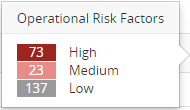Data table
The table contains the information about the components and subprojects in this version of the project.
In the component list view of the BOM, click ![]() located in the far-right column
to modify, ignore, and (for manually added components), delete components or subprojects from the BOM.
located in the far-right column
to modify, ignore, and (for manually added components), delete components or subprojects from the BOM.
When you edit a component (using the BOM or Source tab), an information icon (![]() ) appears in the table row to indicate that a manual adjustment was made to
this component:
) appears in the table row to indicate that a manual adjustment was made to
this component:

Click ![]() to open the Component Details dialog box which displays the edits made to
this component.
to open the Component Details dialog box which displays the edits made to
this component.
The data table has the following columns:
- First column
- Component
- Source
- Match Type
- Match Score
- Usage
- License
- Security Risk
- Cryptography
- Operational Risk
First column (N/A)
Icons shown to the left of the component or subproject name:
-
 Policy violation has been overridden.
Policy violation has been overridden. -
 Component or subproject has not been reviewed.
Component or subproject has not been reviewed. -
 Component or subproject has been reviewed.
Component or subproject has been reviewed.
Component
For subprojects: name and version of the project.
Select a subproject version to open the Details tab for this project version. This page lists the projects where this project version is included as a subproject.
For components: name, version, and if applicable, distribution of the component in use in this version of your project.
Components shown are top-level (parent) and subcomponents (children).
-
Select the version number to open Black Duck KB component version page which displays a list of the projects and project versions in which this version of the component is used.
-
Select ?, which indicates an unknown version, to open the Black Duck KB component page which provides general information about the component.
-
Mouse over the component to view the origin and origin ID.
If the component version has multiple origin IDs, they will be listed in the popup.
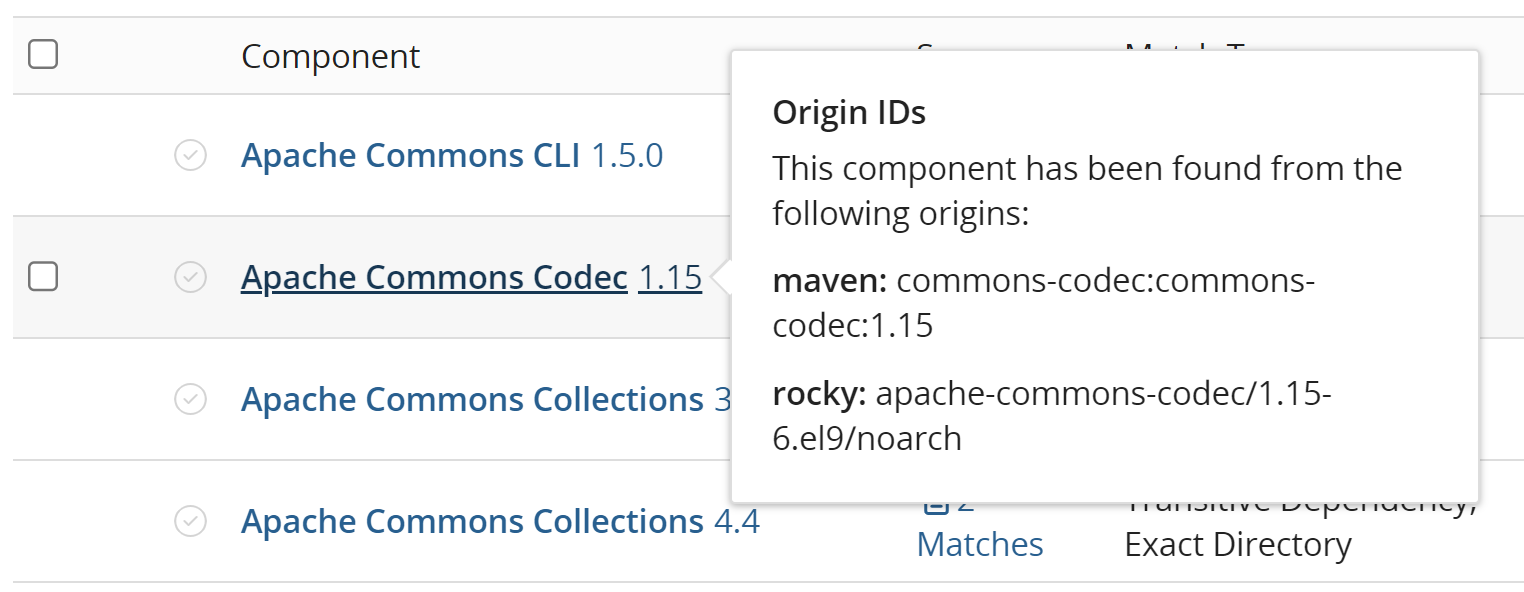
Note: If a component has more than one origin for a version, the table displays the highest risk values.If the component version's origin is not specified, the popup will notify you that the license risks for this component are estimated and that you should manually specify a version for a more accurate result.
If the component's version cannot be identified, the popup will indicate as such.
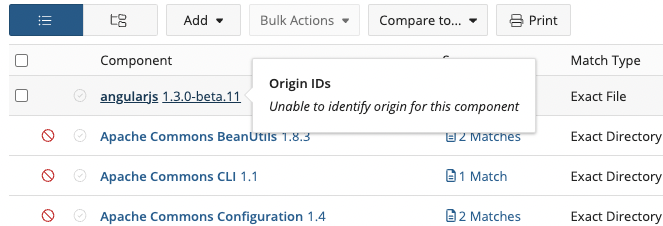
Source
For components: Number of archives or files that match. For example: 
For automatic matches, the number of files that were identified in the component scan and matched to this version of the component appears. Select the text to open the Source tab.
For subprojects: Number of components in the subproject. For example: 
Select the value to open the BOM for this project version. The BOM only appears if you have permission to view the project.
Match type
Indicates how the match between the component in use in this version of your project and a specific version of a project in Black Duck KB was made.
Possible values are:
-
Binary. Binary match from Black Duck Binary Analysis.
-
Direct Dependency. Direct dependency identified via package manager scanning.
-
Direct Dependency Binary. Direct dependency identified from the Black Duck Binary Analysis.
-
Exact Directory. Exact directory match from Signature scanning or Binary Analysis.
-
Exact File. Exact file match from Signature scanning or Binary Analysis.
-
File Dependency. Deprecated and no longer used.
-
Files Added/Deleted. A fuzzy signature match to a directory where some of the OSS component's files were added, deleted, or modified in the scanned archive. This may be a match to a previous or subsequent version of the component, which might have been missing from Black Duck KB at the time that the match was made.
-
Files Modified. A fuzzy signature match to a directory where some of the archive files were modified. This may be a match to a previous or subsequent version of the component, which might have been missing from Black Duck KB at the time that the match was made.
-
Manually Added. Component manually added to BOM in Black Duck.
-
Manually Identified. Manually identified BOM component related to signature match files.
-
Manually Identified Package. Manually identified BOM component related to a identified package manager package.
-
Partial. Deprecated no longer used.
-
Snippet. Snippet scanning identified a portion of code in your file that matches code in one or more KnowledgeBase files. More details about snippets can be found here.
-
SBOM. Imported from a SBOM.
-
Transitive Dependency. Transitive dependency identified via package manager scanning.
-
Transitive Dependency Binary. Transitive dependency identified from the Black Duck Binary Analysis.
When viewing Components in the various views (Component Tab, Source Tab, etc), precedence of "Direct Dependency" over "Transitive Dependency" is given. If the source hierarchy has a component as both a Direct and Transitive Dependency, the "Match Type" field will always show that component as a Direct Dependency even when viewing the transitive dependency in the Source Tree.
The following are automatic matches from an imported Protex BOM:
-
Exact
-
Partial
-
File Dependency
Click here for more information.
The match type for subprojects is Manually Added.
Match score
Indicates the level of confidence that a particular matched component is in fact the component and version displayed.

The overall match score is calculated based on two factors:
-
Degree of ambiguity: The number of possible matches for this component (including the one selected in Black Duck).
-
Percentage of KnowledgeBase artifact matched: This value represents the percent of a KnowledgeBase Download from the BOM Entry's data which matched the customer's scanned data. The KnowledgeBase's representation of the BOM Entry may have many downloads. The % of KnowledgeBase Artifact Matched is based on the Download with the highest percent match to the customer's scanned files.
The match score value does not change after a BOM component (resulting from a signature scan) is edited or modified.
The match score will appear as one of three colors:
- Red if the score is below the "remove" threshold (this means it will be removed from the BOM on the next scan)
- Yellow if the score is within the "warning" threshold
- Gray otherwise

Clicking on a match score displays a small popover that reveals the additional details about the match score (including the other values discussed above):
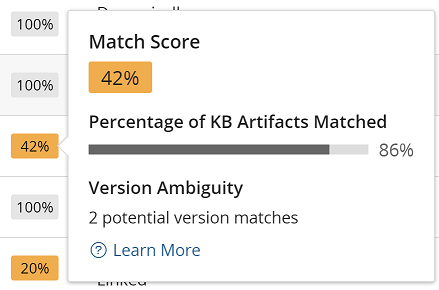
If the component is in the red threshold, and will be removed on the next scan, we show a warning:
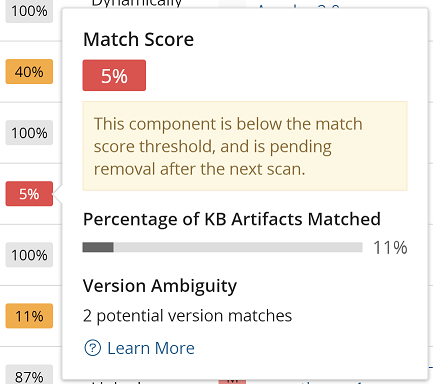
Usage
For components: Indicates how this component is intended to be included in the project when this version is released. For example, if scanning identified development tools in scanned code or a Docker image, you will want to indicate in the BOM that they will not actually be included in the released version of the project.
The possible usage statuses are:
-
Dynamically linked. A moderately-integrated component that is dynamically linked in, such as with DLLs or
.jarfiles. This is the default value. -
Statically linked. A tightly-integrated component that is statically linked in and distributed with your project.
-
Source Code. Source code such as
.javaor.cppfiles. Could be used when packaging a component's sources with the build, a binary, or distribution; usually due to open source requirements. -
Separate Work. Intended for loosely-integrated components. Your work is not derived from the component. To be considered a separate work, your application has its own executables, with no linking between the component and your application. An example is including the free Acrobat PDF Viewer with your distribution media.
-
Merely Aggregated. Intended for components that your project does not use or depend upon in any way, although they may be on the same media. For example, a sample version of an unrelated product included with your distribution.
-
Implementation of Standard. Intended for cases where you implemented according to a standard. For example, a Java spec request that ships with your project.
-
Prerequisite. Intended for components that are required but not provided by your distribution.
-
Dev. Tool / Excluded. Component will not be included in the released project. For example, a component that is used internally for building, development, or testing. Examples are unit tests, IDE files, or a compiler.
-
Unspecified. The usage for this component has not yet been determined. You can use Unspecified to indicate that you need to investigate the usage of this component.
For subprojects, usage defaults to Dynamically Linked, as described above.
License
Declared license of the component or subproject in use in this version of your project.
-
 indicates that the component/subproject has a high license risk.
indicates that the component/subproject has a high license risk. -
 indicates that the component/subproject has a medium license
risk.
indicates that the component/subproject has a medium license
risk. -
 indicates that the component/subproject has a low license risk.
indicates that the component/subproject has a low license risk. -
 (white box) indicates that there is no license risk.
(white box) indicates that there is no license risk.
For known licenses, select the license name to view license details and license text.
In the component list view, if the license text on the BOM page indicates that there is more than one license for this component version (for example the text states "Apache 2.0 and 3 more..."), hover over the license name to view the names of all licenses.
Click here for more information on how license risk for a component is determined.
Security risk
Number of critical/high or high risk (100% red), medium risk (50% red), and low risk (100% gray) vulnerabilities associated with this version of the component or with the subproject:
Select a value to open the project version page Security tab which displays the vulnerabilities for that component or subproject. If the component has an unknown version, a modal will be displayed detailing the estimated security risk for the component.
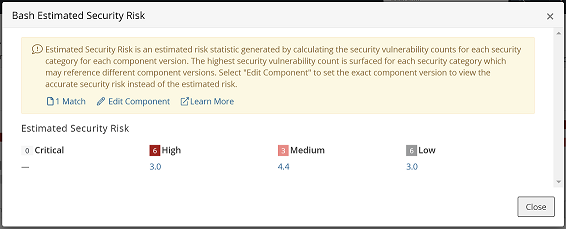
For subprojects, the value shown is the total number of vulnerabilities for all components. Note that the values shown here may not match the values shown on the subproject version's BOM page as that lists the number of components with a vulnerability.
Indicates that this component version has encryption algorithms.
Operational risk
Operational risk level for the component or subproject in use in this version of your project:
-
 High risk
High risk -
 Medium risk
Medium risk -
 Low risk
Low risk
The operational risk level in this version of your project is calculated using a combination of:
-
Version status. Part of the component's operational risk calculation is based on the version of the component used compared to the number of newer versions that have been released and the time since the newest version was released. Using older versions of a component is considered risky when newer versions are available.
-
Activity status. Part of the component's operational risk calculation is based on the commit activity trend for the component over the last 12 months. Increasing or stable commit activity over the time frame is considered less risky than decreasing commit activity over that time frame.
The final operational risk will be the higher of these two risk calculations.
In the component list view, for components, hover over the value to view the factors that determined the value shown:
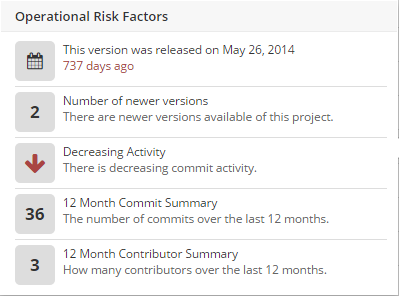
In the component list view, for subprojects, hover over the value to see the number of components in this project version for each operational risk level:
